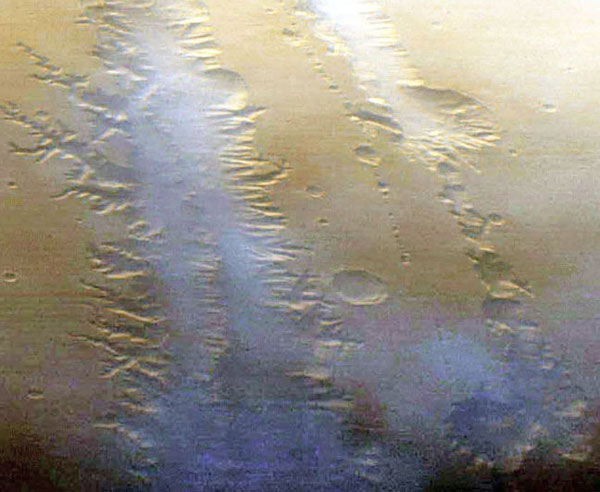|

by David Talbott
from
Thunderbolts Website
Apr 08, 2005

One of the great wonders of the solar system, Valles Marineris on
the planet Mars still defies every conventional attempt to explain
it. From an electric viewpoint of the cosmos, it is the scar of a
cosmic thunderbolt.
Valles Marineris is four times deeper than the Grand Canyon, and
stretches for almost 3,000 miles across the face of Mars. Its
presence has continued to baffle scientists. When the Mariner probes
returned the first pictures of this continental-scale trench, many
proposed catastrophic flooding as its cause. But scrutiny of later
images revealed no outwash or debris field left by erosion, and no
sign of ponding. Nor did the short “tributaries”, ending in cleanly
cut alcoves, fit any reasonable profile of a drainage system. Later
probes revealed the signature of olivine in deep strata of the
chasm. Since olivine readily reacts with water, its presence clearly
excluded water erosion.
What force, then, could have removed two million cubic kilometers
from the Martian surface? Geologists began to speculate about
“unknown” causes of surface spreading and “mass-wasting” on a scale
never before imagined. Prior models of planetary evolution had
envisioned an isolated and inactive surface remaining undisturbed
for billions of years. At best only modest internal geology was
anticipated, and certainly nothing on the scale presented by Valles
Marineris.
In the early 1970s, however, one of the true scientific pioneers of
the 20th century, Ralph Juergens, proposed that in an earlier epoch
of planetary upheaval, electrical arcs between celestial bodies
created many geologic features of the Moon and Mars. As for Valles
Marineris, Juergens wrote in 1974—
“..this entire region resembles nothing so much as an area zapped by
a powerful electric arc advancing unsteadily across the surface,
occasionally splitting in two, and now and then-weakening, so that
its traces narrow and even degrade into lines of disconnected
craters.”
In the years that followed Juergens’ groundbreaking work, Wallace
Thornhill and his collaborators have greatly extended the
investigation of electricity in solar system evolution. A flood of
data from other planets and moons has reinforced their work, all
pointing to the role of electric discharge in sculpting the surfaces
of these bodies. According to Thornhill, “Valles Marineris was
created within minutes by a giant electric arc sweeping across the
surface of Mars. Rock and soil were lifted into space and some fell
back to create the great, strewn fields of boulders first seen by
the Viking and Pathfinder landers.”
Thornhill suggests that the discharge across the Martian surface
took the characteristic form of one of the most majestic cosmic
discharges in the Universe – the barred-spiral galaxy. See “Spiral
Galaxies & Grand Canyons”. It includes the enigmatic “chaos” regions and vast scoured channels
to the east and west.
As in arc welding, material from the electrode will be accelerated
upwards against gravity. This means that any electrical event
capable of creating the Valles Marineris on Mars would likely throw
huge volumes of rock into space, creating vast debris clouds. Some
of the ejecta would encircle Mars or fall back to the planet, while
other material would presumably escape the battlefield altogether,
to be encountered by the Earth and other planets across the
millennia.
The electric interpretation thus removes another conundrum. It
explains why Martian meteorites have arrived at Earth to perplex
physicists and geologists. Until the signature of Martian atmosphere
in these meteorites was identified beyond any reasonable doubt, the
experts said that such rocks could not achieve escape velocity from
Mars without being vaporized by the explosive force required.
Electrical acceleration, however, faces no such dilemma. For
millennia afterwards we might also expect the Earth to periodically
encounter clouds of rusty red dust, the residue of Martian surface
material removed by interplanetary lightning. This too appears to
have occurred right up to the twentieth century.
The event that created Valles Marineris lofted into space something
like 10,000 trillion tons of rock and dust. This can only mean that
there have been far more Martian meteorites and falls of dust on
Earth than geologists have recognized.
Is it possible then, that the “planet of mysteries" has remained
obscure through the space age primarily because of mistaken beliefs?
In earlier Pictures of the Day, we have noted the
evidence for
electric activity still occurring on Mars, as dust devils and
dust
storms. We have reported the experimental work of plasma physicist
C
J Ransom who, inspired by the confidence of the electric theorists,
reproduced the
Martian “blueberries”
in a simple electrical
experiment. This, in turn, provided a direct analog for one of the
most baffling mysteries of all — the Martian domed craters. Yet even
more baffling from any conventional vantage point is the repeated
proximity of these domed craters to
“wormy” trenches.
Not one of these paradoxes, however, lies outside the predictive and
explanatory power of the Electric Universe.
|
